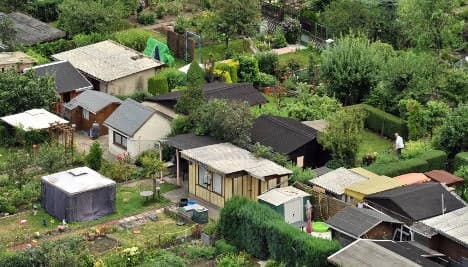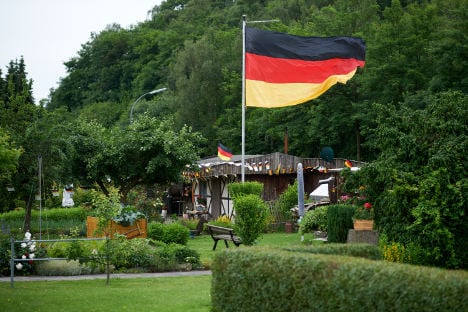'Look at those German shanty towns!'

Visitors to Germany can sometimes be confused by the country's love of allotments in cities, known as a Kleingarten. Teacher and blogger Kathleen Ralf tells us what it's all about.
A few years back I was travelling from downtown Berlin to Wannsee with a group of teachers from Washington State. I was enjoying the views of city life from high above on the rails. The clickity-clack of the tram lulled me into a half asleep-half awake sort of consciousness.
One of the teachers pointed at something out the window and shrieked in an embarrassingly loud voice, “Oh! Those poor people! Look at those shanty towns!”
I woke up out of my dream state to see what she was pointing at, expecting a view of Rio-like favelas, cardboard houses, or possibly stacked wood crates supporting tin roofs. Instead I saw rows of Kleingärten (Schrebergärten), all neatly kept, beginning to wake up in the spring sunshine.
As teachers do, I tried to ease her worries and explain to her that she was not looking upon the poorest of the poor, but instead the small Shangri-La gardens of city dwellers.
Food and leisure
As the Industrial Age began to disconnect people from the land, a few German visionaries saw the need to keep people connected to the farm. More and more people were moving to the cities to work, their diets were deteriorating, and the children had no green spaces on which to frolic.
In 1865, a man named Mortiz Schreber asked the city of Leipzig to lease municipal land for urban gardens. The land would be divided into small allotments that people could use as their own backyards.

At first, the gardens were supposed to be places for children to play outdoors, but later people began to utilize these plots to grow food at a minimal cost.
The Kleingarten movement spread across Germany, Austria, and Switzerland. No longer were these gardens just for the poor, they were gardens for all walks of life.
War-time
During World War II the Kleingarten was also a place of refuge. On most garden plots stands a tiny cabin.
This shack serves as a place to house your tools and chairs, but these huts are also big enough to hold a small table, a stove, and even a cot.
Inge Deutschkron and other Holocaust survivors wrote about being hidden for a time in these huts.
And many German families escaped the night bombings by hiding in these gardens.
My own family speaks of how they wouldn't have survived after the fire bombings in Hamburg without the food they were able to grow in their Kleingarten.
Shangri-La
We don’t have a Kleingarten of our own so we like to visit our friends’ garden. Last Wednesday we enjoyed a long evening of telling stories around the picnic table.
The television tower was turning pink from the setting sun, signaling it was time to journey home.
My poor child had school in the morning, but we wanted to spend just a few more moments in the shaded garden away from the summer heat.
We cleared the picnic table, packed up the chairs and garden tools, and promised to return soon to the little Shangri-La in the city.
You can read more from Kathleen Ralf on her blog. To have your blog published on Expat Dispatches email [email protected]
Comments
See Also
A few years back I was travelling from downtown Berlin to Wannsee with a group of teachers from Washington State. I was enjoying the views of city life from high above on the rails. The clickity-clack of the tram lulled me into a half asleep-half awake sort of consciousness.
One of the teachers pointed at something out the window and shrieked in an embarrassingly loud voice, “Oh! Those poor people! Look at those shanty towns!”
I woke up out of my dream state to see what she was pointing at, expecting a view of Rio-like favelas, cardboard houses, or possibly stacked wood crates supporting tin roofs. Instead I saw rows of Kleingärten (Schrebergärten), all neatly kept, beginning to wake up in the spring sunshine.
As teachers do, I tried to ease her worries and explain to her that she was not looking upon the poorest of the poor, but instead the small Shangri-La gardens of city dwellers.
Food and leisure
As the Industrial Age began to disconnect people from the land, a few German visionaries saw the need to keep people connected to the farm. More and more people were moving to the cities to work, their diets were deteriorating, and the children had no green spaces on which to frolic.
In 1865, a man named Mortiz Schreber asked the city of Leipzig to lease municipal land for urban gardens. The land would be divided into small allotments that people could use as their own backyards.

At first, the gardens were supposed to be places for children to play outdoors, but later people began to utilize these plots to grow food at a minimal cost.
The Kleingarten movement spread across Germany, Austria, and Switzerland. No longer were these gardens just for the poor, they were gardens for all walks of life.
War-time
During World War II the Kleingarten was also a place of refuge. On most garden plots stands a tiny cabin.
This shack serves as a place to house your tools and chairs, but these huts are also big enough to hold a small table, a stove, and even a cot.
Inge Deutschkron and other Holocaust survivors wrote about being hidden for a time in these huts.
And many German families escaped the night bombings by hiding in these gardens.
My own family speaks of how they wouldn't have survived after the fire bombings in Hamburg without the food they were able to grow in their Kleingarten.
Shangri-La
We don’t have a Kleingarten of our own so we like to visit our friends’ garden. Last Wednesday we enjoyed a long evening of telling stories around the picnic table.
The television tower was turning pink from the setting sun, signaling it was time to journey home.
My poor child had school in the morning, but we wanted to spend just a few more moments in the shaded garden away from the summer heat.
We cleared the picnic table, packed up the chairs and garden tools, and promised to return soon to the little Shangri-La in the city.
You can read more from Kathleen Ralf on her blog. To have your blog published on Expat Dispatches email [email protected]
Join the conversation in our comments section below. Share your own views and experience and if you have a question or suggestion for our journalists then email us at [email protected].
Please keep comments civil, constructive and on topic – and make sure to read our terms of use before getting involved.
Please log in here to leave a comment.